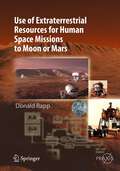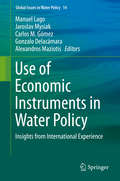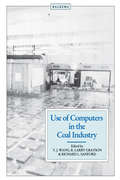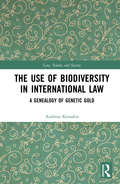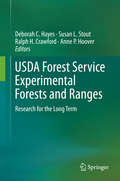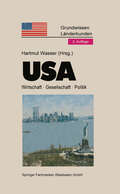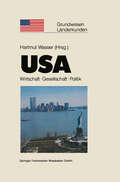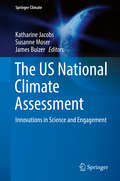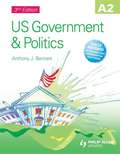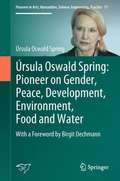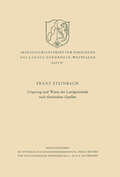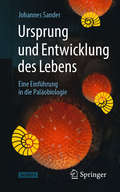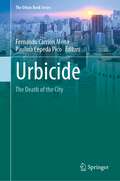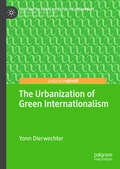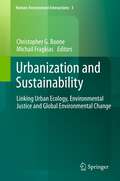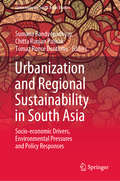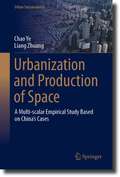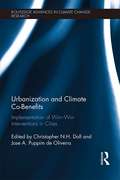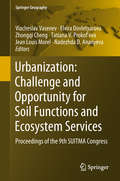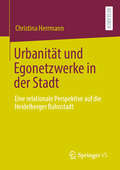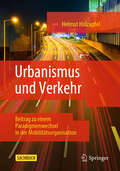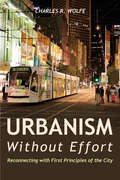- Table View
- List View
Use of Extraterrestrial Resources for Human Space Missions to Moon or Mars (Springer Praxis Books)
by Donald RappThis book carries out approximate estimates of the costs of implementing ISRU on the Moon and Mars. It is found that no ISRU process on the Moon has much merit. ISRU on Mars can save a great deal of mass, but there is a significant cost in prospecting for resources and validating ISRU concepts. Mars ISRU might have merit, but not enough data are available to be certain. In addition, this book provides a detailed review of various ISRU technologies. This includes three approaches for Mars ISRU based on processing only the atmosphere: solid oxide electrolysis, reverse water gas shift reaction (RWGS), and absorbing water vapor directly from the atmosphere. It is not clear that any of these technologies are viable although the RWGS seems to have the best chance. An approach for combining hydrogen with the atmospheric resource is chemically very viable, but hydrogen is needed on Mars. This can be approached by bringing hydrogen from Earth or obtaining water from near-surface water deposits in the soil. Bringing hydrogen from Earth is problematic, so mining the regolith to obtain water seems to be the only way to go. This will require a sizable campaign to locate and validate useable water resources. Technologies for lunar ISRU are also reviewed, even though none of them provide significant benefits to near-term lunar missions. These include oxygen from lunar regolith, solar wind volatiles from regolith, and extraction of polar ice from permanently shaded craters.
Use of Economic Instruments in Water Policy: Insights from International Experience (Global Issues in Water Policy #14)
by Manuel Lago Jaroslav Mysiak Carlos M. Gómez Gonzalo Delacámara Alexandros MaziotisThis book assesses both the effectiveness and efficiency of implemented Economic Policy Instruments (EPIs) in order to achieve water policy goals and identifies the preconditions under which they outperform alternative (e.g. regulatory) policy instruments and/or can complement them as part of complex policy mixes. The development of a consolidated assessment framework helps clarify (and where possible, quantify) the effectiveness of each EPI on the basis of different criteria. Outcome-oriented criteria describe how the EPIs perform. They include intended and unintended economic and environmental outcomes and the distribution of benefits and costs among the affected parties. These steps consider the application of cost effectiveness and cost benefits analysis, e.g. to assess ex-post performance of the EPI. Process criteria describe the institutional conditions (legislative, political, cultural, etc.) affecting the formation and operation of the EPI studied (particularly relevant for assessing the possible impacts of using economic instruments), the transaction costs involved in implementing and enforcing the instruments and the process of implementation.Case studies from Cyprus, Denmark, France, Germany, Hungary, Italy, the Netherlands, Spain and the United Kingdom, as well as from Australia, Chile, Israel and the USA are presented in this book. A wide variety of EPIs are also covered, including water-pricing schemes (tariffs, environmental taxes, environmental charges or fees, subsidies on products and practices), trading schemes (tradable permits for abstraction and pollution) and cooperation mechanisms.
Use of Computers in the Coal Industry 1986
by Y. J. WangThis book is an outcome of the third conference on the use of computers in the coal industry in Morgantown. It presents valuable computer applications covering the most aspects of coal industry and covers following areas: mine management and economics; surface mining; coal preparation; and blasting.
Use of Computers in the Coal Industry 1986
by Y.J. Wang, R. Larry Grayson and Richard L. SanfordThis book is an outcome of the third conference on the use of computers in the coal industry in Morgantown. It presents valuable computer applications covering the most aspects of coal industry and covers following areas: mine management and economics; surface mining; coal preparation; and blasting.
The Use of Biodiversity in International Law: A Genealogy of Genetic Gold (Law, Science and Society)
by Andreas KotsakisThis book presents a legal genealogy of biodiversity – of its strategic use before and after the adoption of the Convention on Biological Diversity, 1993. This history of ‘genetic gold’ details how, with the aid of international law, the idea of biodiversity has been instrumentalized towards political and economic aims. A study of the strategic utility of biodiversity, rather than the utility of its protection under international law, the book’s focus is not, therefore, on the sustainable or non-sustainable use of biodiversity as a natural resource, but rather on its historical use as an intellectual resource. Although biodiversity is still not being effectively conserved, nor sustainably used, the Convention on Biological Diversity and its parent regime persists, now after several decades of operation. This book provides the comprehensive answer to the question of the convention’s continued existence. Drawing from environmental history, the philosophy of science, political economy and development studies, this book will be of interest to advanced undergraduate and postgraduate students in Environmental Law, International Law, Environmental Studies, and Ecology.
The Use of Biodiversity in International Law: A Genealogy of Genetic Gold (Law, Science and Society)
by Andreas KotsakisThis book presents a legal genealogy of biodiversity – of its strategic use before and after the adoption of the Convention on Biological Diversity, 1993. This history of ‘genetic gold’ details how, with the aid of international law, the idea of biodiversity has been instrumentalized towards political and economic aims. A study of the strategic utility of biodiversity, rather than the utility of its protection under international law, the book’s focus is not, therefore, on the sustainable or non-sustainable use of biodiversity as a natural resource, but rather on its historical use as an intellectual resource. Although biodiversity is still not being effectively conserved, nor sustainably used, the Convention on Biological Diversity and its parent regime persists, now after several decades of operation. This book provides the comprehensive answer to the question of the convention’s continued existence. Drawing from environmental history, the philosophy of science, political economy and development studies, this book will be of interest to advanced undergraduate and postgraduate students in Environmental Law, International Law, Environmental Studies, and Ecology.
USDA Forest Service Experimental Forests and Ranges: Research for the Long Term
by Deborah C. Hayes Susan L. Stout Ralph H. Crawford Anne P. HooverUSDA Forest Service Experimental Forests and Ranges (EFRs) are scientific treasures, providing secure, protected research sites where complex and diverse ecological processes are studied over the long term. This book offers several examples of the dynamic interactions among questions of public concern or policy, EFR research, and natural resource management practices and policies. Often, trends observed – or expected -- in the early years of a research program are contradicted or confounded as the research record extends over decades. The EFRs are among the few areas in the US where such long-term research has been carried out by teams of scientists. Changes in society’s needs and values can also redirect research programs. Each chapter of this book reflects the interplay between the ecological results that emerge from a long-term research project and the social forces that influence questions asked and resources invested in ecological research. While these stories include summaries and syntheses of traditional research results, they offer a distinctly new perspective, a larger and more complete picture than that provided by a more typical 5-year study. They also provide examples of long-term research on EFRs that have provided answers for questions not even imagined at the time the study was installed.
The US National Climate Assessment: Innovations in Science and Engagement (Springer Climate)
by Katharine Jacobs Susanne Moser James BuizerThis book offers valuable climate policy and climate assessment lessons, depicting what it takes to build a sustained climate assessment process. It explores the third U.S. National Climate Assessment (NCA3) report as compared with previous US national climate assessments, from both a process and content perspective. The U.S. Global Change Research Program is required by law to produce a National Climate Assessment report every four years, and these reports provide a comprehensive evaluation of climate science as well as observed and projected climate impacts on a variety of sectors. As the book describes, a key contribution of the NCA3 approach is a far more deliberate interdisciplinary process, as well as an engagement strategy that brought hundreds of public and private sector stakeholders into the assessment community. Among its most important conceptual contributions was an explicit focus on building the infrastructure to conduct better assessments over time and an experimental approach to analysis of the impacts of climate on cross-sectoral systems and inter-locking and cascading effects across sectors. Readers may explore innovations such as the development of regional climatologies and projections for every region of the US, as well as the development of the Global Change Information System. The book also highlights the need for decision-makers to be part of the assessment process, in order for assessment findings to be truly useful from a decision-maker's perspective. Many lessons have been learned by the NCA3 authors that can be useful in future assessments and adaptation processes, both within the US and internationally. This book passes on such lessons and includes an evaluation of the role of state climate assessments in ongoing national assessment processes.
US Government and Politics (PDF)
by Anthony J BennettThis highly popular textbook has been written specifically to meet the needs of A2 students, providing comprehensive, accessible and up-to-date coverage of core topics in US and comparative government and politics. Carefully structured around the specifications, the textbook combines authoritative discussion with the latest facts and figures. Frequent Summary boxes and definitions of Key Terms aid comprehension and revision, while an Exam Focus section at the end of each chapter offers source-based exercises relating to the text and assignments for extension work, drawing on further reading. This bestselling textbook has been completely revised to meet the needs of A2 students using the recent A2 specifications. It provides comprehensive, accessible and up-to-date coverage of the US and comparative US/UK topics on the main exam board specifications. The third edition has been fully updated to include the 2008 presidential election.
Úrsula Oswald Spring: With a Foreword by Birgit Dechmann (Pioneers in Arts, Humanities, Science, Engineering, Practice #17)
by Úrsula Oswald SpringThis book aims to initiate among students and other readers critical and interdisciplinary reflections on key problems concerning development, gender relations, peace and environment, with a special emphasis on North-South relations. This volume offers a selection of the author's research in different parts of the world during 50 years of contributing to an interdisciplinary scientific debate and addressing social answers to urgent global problems. After the author's biography and bibliography, the second part analyses the development processes of several countries in the South that resulted in a dynamic of underdevelopment. The deep-rooted gender discrimination is also reflected in the destructive exploitation of natural resources and the pollution of soils, water and air. Since the beginning of the Anthropocene in the mid-20th century, the management of human society and global resources has been unsustainable and has created global environmental change and multiple conflicts over scarce and polluted resources. Peace and development policies aiming at gender equity and sustainable environmental management, where water and food are crucial for the survival of humankind, focus on systemic alternatives embedded in a path of sustainability transition.• This book reviews multiple influences from Europe, Africa and Latin America on a leading social scientist and activist on gender, development and environment aiming at a world with equity, sustainability, peace and harmony between nature and humans.• This pioneer volume analyses social and environmental conflicts and peace processes in Latin America, with a special focus on Mexico, by addressing the development of under-development, global environmental change, poverty, nutrition and the North-South gap.• This volume focuses on environmental deterioration with a special emphasis on food and water and proposes systemic changes towards a sustainability transition with peace, regional development and gender equity.• This pioneering work offers alternative approaches to regional development, food sovereignty and holistic development processes from a gender perspective.
Ursprung und Wesen der Landgemeinde nach rheinischen Quellen (Arbeitsgemeinschaft für Forschung des Landes Nordrhein-Westfalen #87)
by Franz SteinbachUrsprung und Entwicklung des Lebens: Eine Einführung in die Paläobiologie
by Johannes SanderSie wollten schon immer einmal wissen, wie das Leben begann, sich entfaltete und schließlich zu seiner heutigen Form fand? Das vorliegende Buch bietet Ihnen einen kurzen, gleichzeitig aber auch umfassenden Einblick in diese spannende Entwicklung. Ausgehend von den kosmischen Prozessen, die die Voraussetzungen für die Entstehung von Leben auf der Erde schufen, über die Entstehung des Lebens selbst bis hin zu der weiteren Evolution des Lebens über die Jahrmillionen hinweg, erhalten Sie einen weitreichenden Einblick in diese Abläufe. Zudem erklärt dieses Buch die Hintergründe und Ursachen für die Entwicklung in bestimmte Richtungen. Berücksichtigt werden dabei neben den oft im Vordergrund stehenden Wirbeltieren auch Mikroorganismen, Pflanzen und Insekten. Zuletzt beschreibt das Buch anschaulich die Entwicklung des Menschen – jener Spezies, mit der uns alle eine besondere Beziehung verbindet!
Urbicide: The Death of the City (The Urban Book Series)
by Fernando Carrión Mena Paulina Cepeda PicoThis book uses the reflection of academics specialized in the urban area of Latin America, Europe and the United States, to initiate a comparative debate of the different dynamics in which Urbicidio expresses itself. The field or focal point of analysis that this publication approaches is the city, but under a new critical perspective of inverse methodology to that has been traditional used. It is about understanding the structural causes of self-destruction to finally thinking better and then going from pessimism to optimism.It is a deep look at the city from an unconventional entrance, because it is about knowing and analyzing what the city loses by the action deployed by own urbanites, both in the field of its production and in the field of its consumption. This suppose that the city does not have an ascending linear sequential evolution in its development but neither in each of its parts in the improvement process, showing the face that commonly not seen but others live. The category used for this purpose is that of Urbicidio or the death of the city, which contributes theoretically and methodologically to the knowledge of the city, as well as to the design of urban policies that neutralize it. In addition, it is worth mentioning that the book has an inclusive view of the authors. For this reason, gender parity, territorial representation and the presence of age groups have been sought.
The Urbanization of Green Internationalism (Cities and the Global Politics of the Environment)
by Yonn DierwechterThe recent rise of cities in global environmental politics has stimulated remarkable debates about sustainable urban development and the geopolitics of a changing world order no longer defined by tightly bordered national regimes. This book explores this major theme by drawing on approaches that document the diverse histories and emergent geographies of “internationalism.” It is no longer possible, the book argues, to analyze the global politics of the environment without considering its various urbanization(s), wherein multiple actors are reforming, reassembling and adapting to nascent threats posed by global ecological decay. The ongoing imposition and abrasion of different world orders—Westphalian and post-Westphalian—further suggests we need a wider frame to capture new kinds of urbanized spaces and global green politics. The book will appeal to students, scholars, and practitioners interested in global sustainability, urban development, planning, politics, and international affairs. Case studies and grounded examples of green internationalism in urban action ultimately explore how select city-regions like Cape Town, Los Angeles, and Melbourne are trying to negotiate and actually work through this postulated dilemma.
Urbanization and Sustainability: Linking Urban Ecology, Environmental Justice and Global Environmental Change (Human-Environment Interactions #3)
by Christopher G. Boone and Michail FragkiasCase studies explore the Million Trees initiative in Los Angeles; the relationship of cap-and-trade policy, public health, greenhouse gas emissions and environmental justice in Southern California; Urbanization, vulnerability and environmental justice in the Brazilian cities of Rio de Janeiro, Curitiba and São Paulo, and in Antofagasta, Greater Concepción and Valparaiso in Chile; Sociospatial patterns of vulnerability in the American southwest; and Urban flood control and land use planning in Greater Taipei, Taiwan ROC.
Urbanization and Regional Sustainability in South Asia: Socio-economic Drivers, Environmental Pressures and Policy Responses (Contemporary South Asian Studies)
by Sumana Bandyopadhyay Chitta Ranjan Pathak Tomaz Ponce DentinhoThis book examines urbanization and migration processes in South Asia. By analyzing the socio-economic impacts and infrastructural, environmental and institutional aspects of different conurbations, it highlights conflicts over agricultural land as well as the effects on health, education, poverty and the welfare of children, women and old people. The authors also explore issues of mobility; connectivity and accessibility of public services, and discuss the effective use of new urban-management tools, such as the concept of smart cities and urban spatial monitoring.
Urbanization and Production of Space: A Multi-scalar Empirical Study Based on China's Cases (Urban Sustainability)
by Chao Ye Liang ZhuangThis book studies China’s urbanization with the theory of production of space. The authors redefine the production of space and build a new theoretical framework for understanding the evolving relations between urbanization and spatial production. Since the reform and opening-up, especially in the last twenty years, the logic of spatial production has dominated China’s urbanization. The authors choose the most representative cases, such as the Yangtze River Delta Urban Agglomeration, Jiangsu Province, National High-tech Industrial Development Zone, New Urban District, State-Level New Area, University Town, and some villages, to conduct a series of empirical studies on production of space at the macro-, meso-, and micro-scales. Through an in-depth analysis of the interaction between social spaces and urbanization influenced by power, capital, and class, the book reveals that the essence of China’s urbanization is dominated by the logic of spatial production. The authors finally propose that an important shift toward humanism should be made in the future development of China’s new-type urbanization, emphasizing more even and adequate development between different regions and between urban and rural areas, which also provides new ideas for the theory and practice of urbanization worldwide.This book can be read and referenced by researchers in the fields of urban and regional studies, geography, sociology, urban and rural planning, management, etc. It can also be used as a teaching reference book for teachers, researchers, and students of scientific research institutions in related fields.
Urbanization and Climate Co-Benefits: Implementation of win-win interventions in cities (Routledge Advances in Climate Change Research)
by Christopher N.H. Doll and Jose A. Puppim de OliveiraUrban areas are increasingly contributing to climate change while also suffering many of its impacts. Moreover, many cities, particularly in developing countries, continue to struggle to provide services, infrastructure and socio-economic opportunities. How do we achieve the global goals on climate change and also make room for allowing global urban development? Increasing levels of awareness and engagement on climate change at the local level, coupled with recent global agreements on climate and development goals, as well as the New Urban Agenda emerging from Habitat III, present an unprecedented opportunity to radically rethink how we develop and manage our cities. Urbanization and Climate Co-Benefits examines the main opportunities and challenges to the implementation of a co-benefits approach in urban areas. Drawing on the results of empirical research carried out in Brazil, China, Indonesia, South Africa, India and Japan, the book is divided into two parts. The first part uses a common framework to analyse co-benefits across the urban sectors. The second part examines the tools and legal and governance perspectives at the local and international level that can help in planning for co-benefits. This book will be of great interest to students, practitioners and scholars of urban studies, climate/development policy and environmental studies.
Urbanization and Climate Co-Benefits: Implementation of win-win interventions in cities (Routledge Advances in Climate Change Research)
by Christopher N. H. Doll Jose A. Puppim De OliveiraUrban areas are increasingly contributing to climate change while also suffering many of its impacts. Moreover, many cities, particularly in developing countries, continue to struggle to provide services, infrastructure and socio-economic opportunities. How do we achieve the global goals on climate change and also make room for allowing global urban development? Increasing levels of awareness and engagement on climate change at the local level, coupled with recent global agreements on climate and development goals, as well as the New Urban Agenda emerging from Habitat III, present an unprecedented opportunity to radically rethink how we develop and manage our cities. Urbanization and Climate Co-Benefits examines the main opportunities and challenges to the implementation of a co-benefits approach in urban areas. Drawing on the results of empirical research carried out in Brazil, China, Indonesia, South Africa, India and Japan, the book is divided into two parts. The first part uses a common framework to analyse co-benefits across the urban sectors. The second part examines the tools and legal and governance perspectives at the local and international level that can help in planning for co-benefits. This book will be of great interest to students, practitioners and scholars of urban studies, climate/development policy and environmental studies.
Urbanization: Proceedings of the 9th SUITMA Congress (Springer Geography)
by Viacheslav Vasenev Elvira Dovletyarova Zhongqi Cheng Tatiana V. Prokof’eva Jean Louis Morel Nadezhda D. AnanyevaThis proceedings volume focuses on different aspects of environmental assessment, monitoring, and management of urban and technogenic soils. Soils of Urban, Industrial, Traffic, Mining and Military Areas (SUITMAs) differ substantially from their natural zonal counterparts in their physical, chemical and biological features, their performed functions, and supported services.This book discusses the monitoring, analysis and assessment of the effects of urbanization on soil functions and services. Further, it helps to find solutions to the environmental consequences of urbanization and discusses best management practices such as management and design of urban green infrastructure, waste management, water purification, and reclamation and remediation of contaminated soils in the context of sustainable urban development.The book includes thematic sections corresponding to 14 sessions of the SUITMA 9 congress, covering broad topics that highlight the importance of urban soils for society and environment and summarizing the lessons learned and existing methodologies in analyses, assessments, and modeling of anthropogenic effects on soils and the related ecological risks.This proceedings book appeals to scientists and students as well as practitioners in soil and environmental science, urban planning, geography and related disciplines, and provides useful information for policy makers and other stakeholders working in urban management and greenery.
Urbanität und Egonetzwerke in der Stadt: Eine relationale Perspektive auf die Heidelberger Bahnstadt
by Christina HerrmannUrbanität haftet Individuen weder einfach als Habitus an, noch ist sie in einer Stadt per se gegeben. Vielmehr muss auf die Wechselwirkungen von Stadtraum – sozialen Beziehungen – und Einstellungen rekurriert werden, um zu verstehen, wie die sozialen Netzwerke in der Stadt Offenheit für Urbanität hervorbringen. Christina Herrmann betrachtet den geplanten, neu gebauten Heidelberger Stadtteil Bahnstadt als soziales Labor und untersucht lokale soziale Beziehungen, sowie deren Einfluss auf die Offenheit gegenüber Urbanität qualitativ, quantitativ und netzwerkanalytisch. Dabei thematisiert dieses Buch neben klassischen relationalen Ansätzen auch die Diskussion um die nachhaltige Stadt in der Wissensgesellschaft und die Situationen von jungen Familien in der Stadt.
Urbanismus und Verkehr: Beitrag zu einem Paradigmenwechsel in der Mobilitätsorganisation
by Helmut HolzapfelDas Sachbuch, jetzt in der dritten erneut überarbeiteten Auflage beinahe schon ein Klassiker der interdisziplinär begriffenen Verkehrs- und Stadtforschung, ist aktueller denn je. Es vermittelt auf kluge Weise Kenntnisse, der historischen und sozio-kulturellen Wurzeln einer einseitig vom Automobil dominierten Perspektive der Verkehrsplanung. Es zeigt die Entwicklung einer von fossiler Energie getriebenen Planung, die seit Jahrzehnten die sozialen und ökologischen Systeme überfordert, und vermittelt darüber hinaus Lösungsansätze, für eine menschengerechtere Stadt- und Verkehrsorganisation, die nicht ihr Heil in der Distanzüberwindung findet, sondern Qualität in der Nähe. Das völlig neu konzipierte Schlusskapitel zeigt eindringlich, dass der Wandel in Transport und Verkehr, oft als Verkehrswende bezeichnet, ohne einen radikalen Paradigmenwechsel in Verhalten, Städtebau und Mobilitätsorganisation nicht gelingen kann. Die 3. Auflage wird mit einem Vorwort von Jens Hilgenberg, Bund für Umwelt und Naturschutz Deutschland e.V. (BUND), eingeleitet.
Urbanism Without Effort: Reconnecting with First Principles of the City (Island Press E-ssentials Ser.)
by Charles R. WolfeHow do you create inviting and authentic urban environments where people feel at home? Countless community engagement workshops, studies by consulting firms, and downtown revitalization campaigns have attempted to answer this age-old question. In Urbanism Without Effort, Chuck Wolfe argues that “unplanned” places can often teach us more about great placemaking than planned ones. From impromptu movie nights in a Seattle alley to the adapted reuse of Diocletian’s Palace in Split, Croatia, Wolfe searches for the “first principles” of what makes humans feel happy and safe amid the hustle and bustle of urban life. He highlights the common elements of cities around the world that spontaneously bring people together: being inherently walkable, factors that contribute to safety at night, the importance of intersections and corners, and more. In this age of skyrocketing metropolitan growth, he argues, looking to the past might be our best approach to creating the urban future we dream about. A whirlwind global tour, Urbanism Without Effort offers readers inspiration, historical context, and a better understanding of how an inviting urban environment is created.
